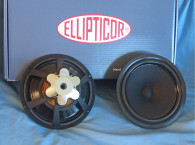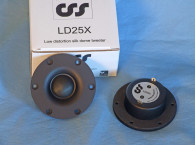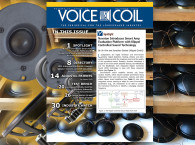



The features for Omega Audio’s ODT29 fabric dome tweeter, seen in Photo 2, include a 29mm hand-coated fabric type diaphragm with a fairly narrow 2mm wide surround, a felt damping ring on the top of the pole piece, ferrite motor, a plastic faceplate with a short waveguide, an aluminum voice coil former wound with copper wire, and gold-plated terminals.
Testing commenced using the LinearX LMS analyzer to produce the 300-point impedance sweep illustrated in Figure 1. The tweeter resonance occurs at a moderately low 730Hz (factory spec is 750Hz). With a 5.55Ω DCR (Re), the minimum impedance for this tweeter is 5.91Ω at 1.5kHz.
Following the impedance test, I recess mounted the Omega Audio tweeter in an enclosure with a baffle area of 15” × 6” and measured the on- and off-axis frequency response using the LoudSoft FINE R+D analyzer (provided by LoudSoft) and the GRAS 46BE 1/4” microphone (courtesy of GRAS Sound & Vibration). The equipment was set up to measure the 200Hz to 40kHz frequency response (using a 192kHz sampling rate) at 2V/0.5m normalized to 2.83V/1m. Sweeps were performed at 0°, 15°, 30°, and 45°.




Figure 2 shows the on-axis response of the ODT29, which measured ±3 dB from 2 kHz to 19 kHz. Figure 3 shows the ODT29’s on- and off-axis responses, with the off-axis curves. Figure 4 shows the curves normalized to the on-axis response. Figure 5 shows the CLIO 180° polar plot (measured in 10° increments with 1/3 octave smoothing). Figure 6 shows the two-sample SPL comparison of the ODT29, indicating the two samples were closely matched to within 1dB throughout its operating range from 2kHz to 10kHz.
For the final group of tests, I fired up the Listen, Inc. SoundCheck analyzer along with the Listen SCM 2 1/4" microphone (provided courtesy of Listen, Inc.) and measured the impulse response with the tweeter recess mounted on the same 15" × 6" test baffle. Importing this data into the Listen SoundMap software produced the cumulative spectral decay (CSD) waterfall plot shown in Figure 7. Figure 8 shows the Short Time Fourier Transform (STFT) displayed as a surface plot. For the SoundCheck final test procedure, I set the 1m SPL to 94dB (7.31V) using a noise stimulus, and measured the second- and third-harmonic distortion at 10cm, depicted in Figure 9.



This article was originally published in Voice Coil, October 2020.









